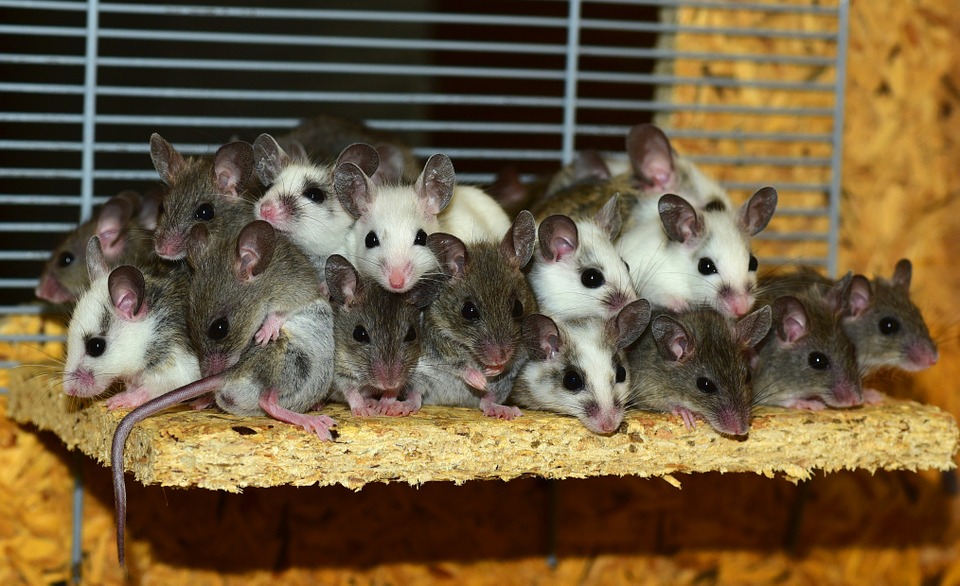Pain researchers forgetting females
Interview with
When investigating pain, most of our studies make rather a big omission - the  mice being tested are all male, which may mean that many females are missing out. Researcher Jeffrey Mogil this week revealed 78% of studies published last year in the journal Pain used only male mice, and urged scientists to include female mice in their studies in future. To find out more Georgia Mills spoke to Dr Ewan St John smith who works on pain at the University of Cambridge.
mice being tested are all male, which may mean that many females are missing out. Researcher Jeffrey Mogil this week revealed 78% of studies published last year in the journal Pain used only male mice, and urged scientists to include female mice in their studies in future. To find out more Georgia Mills spoke to Dr Ewan St John smith who works on pain at the University of Cambridge.
Ewan - Jeff Mogil runs a large research group in Canada and for a long time he's been a proponent of the fact that biomedical scientists have been missing out by focusing most of their rodent research on only using males. And he's got a lot of research suggesting 'hey look, it's very important to consider looking at males and females because there are big differences in the biology and responses to measure to whatever behavioural tests you were doing.' His main area of focus has been pain and he's shown it makes a big difference in certain pain models, and for certain therapies if you're using groups of males versus groups of females you can get different results. His main thing is that researchers should be making a bigger consideration when planning their experiments as to whether they should be using females, males, or a mixture and, if they are only going to be using males, how is that justified and is it justifiable. I mean there may be a reason but that's what his main argument is it's an important factor that lots of people are just ignoring.
Georgia - What proportion of studies are using just male mice?
Ewan - The majority of studies are using just males. If you go back in time the main reason for this is thought to be that females animals obviously have an oestrous cycle, they have hormonal fluxes and, therefore, that will introduce a rather difficult control variable into the studies.
Georgia - Just to play devil's advocate, what's a small thing like gender when you're using an entirely different species?
Ewan - Again, it depends what your research question is. My group focuses a lot on rheumatoid arthritis; this is a condition which is mainly prevalent in females. So one could argue that we don't understand a huge amount about how rheumatoid arthritis is caused and maybe if would be of benefit to focus studies on rheumatoid arthritis on females, or to at least include females and males in studies of a disease that's most common in females. You can track the different members of a study through to see if there are any differences in sex. Sometimes there might be and sometimes there won't be, but if you only focus on males, you might might miss out on something.
Georgia - And what kind of real world implications could this omission be having?
Ewan - Well there's one study that came out several years ago where there was a protein called Toll-like receptor 4 and the research identified that when you knocked this gene out, you remove this gene from the animals they no longer developed neuropathic pain, so that's a sort of pain associated with nerve damage. So this looked like this particular protein would be a good target in understanding more about developing analgesics for treating neuropathic pain, but then it turned out this was only true in males; if you remove the gene in female mice it didn't make any difference. And that's just a piece of evidence along with lots of others from different research groups showing that the biology of how pain is caused at certain levels is different between males and females; some of the stress induced analgesia that is present in males and females has different pathways. So I think there's numerous bits of evidence accumulating suggesting that it's not going to be different at every single point of the pain pathway, but if you don't look you might miss something. Jeff Mogil himself has reanalysed a lot of data that's published and his general feeling is that you can statistically show that females appear to be more sensitive to, and less tolerant of pain than men.
Georgia - Could it be argued then that a whole host of pain treatments are engineered for men and may not be effective for women at all?
Ewan - I don't know about ones that are currently in the clinic but I think the same that if you look at cancer research, scientists are trying to understand more about very specific differences between different sorts of cancers and whether certain subgroups of people would be susceptible to certain treatments and others wouldn't be, so this idea of personalised medicine. I can certainly imagine a case where there will be certain pain medications that may be developed that are far more efficacious in females than men or visa versa. But again, if you don't look to see if there are differences there you are not going to find them, and you may end up developing a treatment that looks great in male mice but fails in clinical trials because your clinical trial may have involved both male and females.









Comments
Add a comment